By LARRY JOSEPH CALLOWAY
In late August of the saddest summer, speeding through the emptiness of Colorado’s South Park on the way to Denver to see “The Book of Mormon” and to attend my high school class reunion, I lightened up by writing. Not texting – that’s unlawful – but writing, which is OK if you do it in your head.
I worked up a concept for an episode of “South Park,” the cartoon where foul-mouthed little kids living in perpetual winter, constantly undermine their politically correct parents. The two former CU-Boulder students who created “South Park” also created “The Book of Mormon.” I was driving through the geographical reality, a national heritage area, wondering how the two satirists were getting away with mocking the sacred reality.
My mind-draft of the episode began with those shitty little kids suspecting their parents of marching with a subversive militia. The adults have been secretly preparing for a demonstration. They have been hailing the image of a uniformed leader and saluting an enemy flag.
The obscene little kids don’t care about plots to overthrow the government, or whatever. Their concern is the rigorous activity will introduce parents to the idea of discipline and this could lead to child discipline or worse – like, military school.
Since every imagined possibility becomes reality on “South Park,” we see the little bastards in military school. They are lined up for inspection by the Leader. He commands them to march, which is hard because they have no legs and can only slide from place to place like magnetic chess pawns and tip over. The secret flag hangs dead on an eagle-topped poll, its savage logo lost in the red folds.
The kid pawns devise a plan of action. They will send out spies to record the un-American parental activities. The videos will be sent to Anderson Cooper, who in turn will convene a panel of experts to analyze the outrageous marching society and shame the parents into restoring lax family values.
Right away the spies develop information indicating the leader’s name is Reb. This fits with other information that some parents, behind closed doors, have rehearsed a song of rebellion ending, “To the purple and the white / Fight! Fight!” And as to the flag. . .
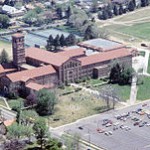
Well, let me explain the background of my high school. It was built in the mid-1920’s to accommodate a real estate boom in wonderful middle-class South Denver, and it was – and still is – monumental. With its eight-story Romanesque clock tower (signs of the zodiac in place of numbers) rising above Washington Park and its art-stone decorations including fearsome gargoyles and its fine brickwork and red tile roofing, it might have been plucked from renaissance Tuscany.
It was one of four regular high schools, objectively named for the four compass points by a school board that valued fine high schools and equality. It assigned team names accordingly. West High was the Cowboys, North the Vikings, East the Angels (they always appear in the east) and South the Rebels. I went to South High.

“Johnny Reb,” a fierce bearded soldier in a slanted gray hat, was our mascot and logo. Our newspaper was “The Confederate.” At football games we did the Rebel yell and waved the Confederate battle flag. These exercises did not raise protests among African-American students at South because there were none, at least none in our class of 700 Yankee Anglos and one beautiful Latina whom we elected senior prom queen.
The offensiveness became known when mandatory school-busing began in the early 1970’s. In about 1980 the first African-American principal suggested renaming South sports teams the Penguins. He froze in his tracks before furious opposition – based on alumni nostalgia and a broadly held opinion that the small gregarious birds are not sufficiently aggressive and intimidating.
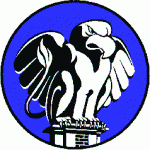
During the ensuing three-decade battle, use of the Confederate symbols declined, and in 2009 the school board accepted a compromise proposed by protesting students. Teams would still called the Rebels, but the mascot would be a scary gargoyle from the monumental building. The logo was inspired by the grotesque architectural figure that stood guard above the main entrance. It is a griffin – a medieval church animal with the body of a lion and the head of an eagle. Johnny Reb was jackhammered from the entrance marble.
I learned all this in conversation at the catered picnic at a restored Washington Park pavilion much in demand for gatherings such as large weddings. We had better things to talk about, of course: like, grandchildren and how recognizable everyone was after . . . sixty (yes, it was the class of 1955) years. The old classmates I talked to had no political reaction, but as in high school I did not talk to the politicians among us.
Next morning during the tour of the school after the memorial service for the 43 per cent of the class who were gone I encountered a young representative of the South High Alumni Association at a table spread with politically revised trinkets and asked about Johnny Reb and his flag. He directed me to a steel staircase descending into the windowless basement where, in those Eisenhower days, the Junior Reserve Officers Training Corps had a rifle range. Leaning against a wall was a gift of the class of 2009: the disgraced soldier in a frame with the words “Johnny Reb, RIP.”
I asked the museum volunteers where his flag was. The two gray women looked at each other and shook their heads.
“It’s not available,” one of them said.
“At least we’re a few years ahead of South Carolina,” I said.
They did not respond.
Matt Stone and Trey Parker, who created “South Park,” would think of a better closing line. I couldn’t.
“At least the flag wasn’t a swastika?” No.
“Was the next mascot Jimmy the Crow?” Uh-uh. . .
The current South principal, Kirstin Waters, a creative educator recognized by Barack Obama in his 2011 state of the union address, told me the students now don’t care much about mascots. I thought, that figures because they are more diverse than we were. And more global. South High has Denver’s program for kids whose first language is not English, and Dr. Walters said 45 languages are spoken. Of the reduced student body of 1,500, grades 9 through 12, (ours was about 2,500, grades 10 through 12) the main groups are: Hispanic 30 percent, African-American 25 per cent, Anglo 25 per cent, and Asian 13 percent.
They call their new gargoyle mascot “Gertie.”
SAME-MAN MARRIAGE
So I could see my South Park episode was inappropriate even for Stone and Parker. Not a good plot for a cartoon on the Comedy Channel. And in my own nostalgic heart my creation during the drive through South Park had become too sad for laughter. I reminisced that we were an enthused class whose fathers, some of them, had returned victorious from a devastating war to care for their families. We lived well in one-bathroom houses with big lawns (no water problems then). We loved the new Chevys and Fords and family vacations on Route 66 and those expensive black and white television sets in better homes. We had grown up playing kick-the-can on tree-shaded side streets with friendly neighbors. We were launched into a bright future from a proud and beautiful high school in a perfectly nice quadrant of a clean high city . . . only to discover within a few years that we offended everybody!
No. You don’t joke about the flag associated with slavery. Politicians who favored it forgot the association. They talked instead about Southern pride and brave soldiers defending against an invader. The Republican Party, after all, had a strong credential. It fought slavery from the beginning. The first party platform, at the convention of 1856 (the year Abraham Lincoln joined), pledged Congressional action to “prohibit in the Territories those twin relics of barbarism – polygamy and slavery.”
So I abandoned the episode. And by synchronistic intervention there occurred immediately, in its place, a new, safer idea: I would create a “South Park” episode about . . . polygamy! It would begin with one of the evil little chess pawns admitting that he had one grandfather and 27 grandmothers. The others would demand a share of them and there would be no retribution because. . . .
Well, polygamy now is admired, no? It can be defended. Millions have been entertained by HBO’s “Big Love.” Even a hundred years ago, the western novelist Zane Grey offered this apology for plural marriage: “One wife for one husband. That’s the law,” he said through a main character in ‘The Rainbow Trail.’ “The Mormons broke the law openly. The Gentiles broke it secretly. And the Mormons took care of their families.” I could use that.
But I would not use the argument of Mark Twain. In an essay about his visit to Salt Lake City in 1861 he wrote that Mormon women were so ugly that: “the man that marries one of them has done an act of Christian charity . . . and the man that marries sixty of them has done a deed of open-handed generosity so sublime that the nations should stand uncovered in his presence and worship in silence.”
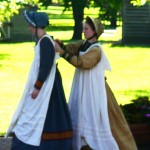
I take exception to this remark in “Roughing It.” I actually lived and worked in Salt Lake about a hundred years after Mark Twain’s visit. Mormon women are not ugly. They are serene and beautiful (although generally inaccessible). They are like Terri Tempest Williams, the Mormon environmental writer. They believe, justly, that their bodies are gifts from God. Some blessed process of evolution must have occurred in the time between Mark Twain’s two-day research project and my two-years of field work.
My other work in Salt Lake was writing and rewriting news stories on teletype keyboards. There were two wire services in America – The Associated Press and United Press International. The AP had only non-Mormon members in Utah and Idaho. All the church-owned newspapers and broadcasters, including the Deseret News and KSL radio and television, subscribed to UPI, which is where I worked the graveyard shift. The masthead of the Deseret News in those days carried a dedication to supporting the U.S. Constitution as a “divinely inspired” document.
The separation of church and state continues to be Mormon doctrine. A leader recently disagreed, for example, with the stance of Kim Davis of Kentucky, the county clerk who refused to follow Supreme Court law on same-sex marriage for religious reasons.
So is the power of the church respectfully political? Many governors of Utah and mayors of Salt Lake have not been Mormons. The state votes Republican, I think, for the same reason the South votes Republican: a historical attachment to states rights. Democratic candidates for president never campaign in Utah, and Republicans don’t have to. President Lyndon Johnson, however, made an impulsive landing in Salt Lake during his 1968 reelection campaign simply to say hello to LDS president David O. McKay. Smart Democrat, LBJ.
If not essentially political, what is the power of the church? In the frontier days it must have been the power to expel non-conforming members. Outcasts had a hard time even surviving, especially if tracked by “Danites,” Brigham Young’s enforcers. But now non-Mormons and inconstant “Jack Mormons” survive quite well. So what is the power of the church?
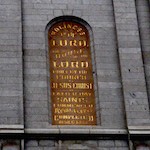 In the evenings, on the way to the UPI bureau in the Salt Lake Tribune building, I would pass the LDS Temple on Main Street. The legend on the central spire read, “Holiness to the LORD. House of the LORD” engraved gold letters.
In the evenings, on the way to the UPI bureau in the Salt Lake Tribune building, I would pass the LDS Temple on Main Street. The legend on the central spire read, “Holiness to the LORD. House of the LORD” engraved gold letters.
All I could see as I drove by was, “LORD! LORD!” I read it as a cry, a plea, like a line from the Psalm: “LORD, come to my assistance. Lord, make haste to help me.”
The Mormons I knew then were not at all uncertain about God. Their Heavenly Father was corporeal and personal. And friendly. “The Lord giveth no commandments unto the children of men save he shall prepare the way for them that they may accomplish the thing which he commandeth them,” according to a prophet named Nephi in the Book of Mormon.
“Adam fell that men might be; and men are, that they might have joy,” says the Book. Given bodies and free will, we have the power “to choose liberty and eternal life” or to choose “captivity and death.” I concluded that this is not a church with a doctrine of original sin, that Mormons are not conceived in sin and born in shame. The LDS religion, I surmised, is humanistic. The Book says that “when ye are in the service of your fellow beings ye are only in the service of your God.”
A modern translation of the Book of Mormon, eliminating the multiple “ye’s” and “unto’s” and “giveth’s,” would make it more readable, but Joseph Smith’s version is the only available source (barring divine reissue of the golden plates disclosed by the angel Moroni). The awkward language likely contributed to Mark Twain’s opinion that the Book is “chloroform in print.” The narrative of an ancient exodus from Jerusalem to America followed by appearances of Jesus here is an “imaginary history, with the Old Testament for a model; followed by a tedious plagiarism of the New Testament,” he wrote. His generous conclusion, however, was: “The Mormon Bible is rather stupid and tiresome to read, but there is nothing vicious in its teachings.” They continue to be nice people.
SINGETH AND DANCETH
“The Book of Mormon” on stage the night after the high school reunion was Mark Twain in song, dance and high-production tableau. Stone, Parker and composer Robert Lopez discarded the institution of plural marriage for their satire. The Church of Jesus Christ of Latter-day Saints renounced polygamy in 1890. But there was more than enough remaining Mormon material to satirize through songs like “Tomorrow Is a Latter Day” or “The All-American Angel” and running gags based on the sacred book’s 19th Century racism and anti-Semitism, which the LDS Church also has renounced.
The audience at the luxurious “Ellie” theatre of The Denver Center for the Performing Arts was well informed about the majority religion of Colorado’s western neighbor. A young man in a seat next to me was telling his companion about the golden angel Moroni, whose copy was perched on the proscenium arch. This staging was startling to me because Moroni is a revered figure. He stands on the highest spire of LDS temples, and Mormons like to say when Jesus returns in the final days the trumpets will sound throughout the world.
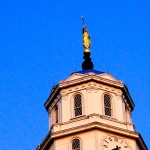
Where? Read on.
“He always faces east,” the guy was telling his girlfriend. (East High Angels flashed through my mind.) I had learned in my sad travels a few weeks earlier that there is one Moroni who faces west. But, having no Ellie companion to appreciate my erudition, I held my tongue. At the opening curtain, Moroni swept back and forth. The mighty trumpet sounded alarmingly.
I had seen the opening number of “The Book of Mormon” televised at an Emmy Awards show – cheerful young missionaries waving the book and ringing your bell and singing “Hello” at your door, their white shirts fresh, their ties straight, their suit pants pressed, their black shoes shined. And I had an abiding curiosity about something. How did the LDS Church respond to the mockery of this Broadway hit?
The major advertiser in the Ellie program was the LDS Church. Three full-page full-color ads artfully depicted in order a white man, an Asian woman, and a black man saying in essence, “You saw the play. Now read the book!” You could just scan the code with your phone and order a free copy. This was consistent with the only official LDS press statement on the musical, which said, in full, “The production may attempt to entertain audiences for an evening, but the Book of Mormon as a volume of scripture will change people’s lives forever by bringing them closer to Christ.”
I had learned to look behind press releases. I would have to go to Salt Lake for the full answer. It was a reasonable detour on my way back from a reunion with old friends on a homestead in western Montana. And I wanted to revisit the historic Mormon Tabernacle, Stradivarius of halls, where I used to rest on evenings off work to hear the Tabernacle Choir rehearse for its Sunday service and national broadcast.
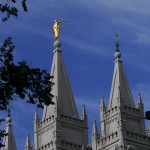
Revisiting the center of this prosperous American city, I was impressed to see how Temple Square has blossomed. Exploded. Modernized. The section of Main Street on which I used to pass by the sharp-spired temple is now an underground parking garage topped by a reflecting pool. The old egg-shaped Tabernacle is squats among high buildings, including the massive skyscraper of the LDS church headquarters and a neighbor with the logo of the church-founded Zions Bank.In the silence of the resonant hall missionary guides used to demonstrate that you could hear a pin drop.
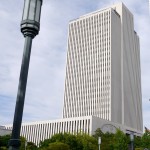
They would gesture to the 150-foot span and recite how it was built in the 1860’s by very skilled people using local stone and timber. They could not afford to import nails or iron from the East for construction. Now the missionaries in the Tabernacle politely stand at a barrier rope and hold back overflowing tourists who might, for example, walk down the center aisle and sit for a while under the ingenious self-supporting dome.
Video panels invited Mormons to a church-sponsored concert that evening. A guide told me a few of the free tickets might be available at the last minute for people like me. (Gentiles, he probably meant but did not say.) The Tabernacle would be full? No, he said, the show was going to be in the LDS Conference Center. I got a ticket and joined the lines of Mormons – beautiful families enjoying the summer evening after arriving in new cars guided to downtown parking by an corps of volunteers. After going through security I stepped into the Conference Center. I was astonished by the parabolic auditorium and stage, perhaps the largest theatre in the world, with 21,000 stadium seats.
The 300-plus Tabernacle Choir and the orchestra were in place with a new pipe organ as a backdrop. The soprano soloist was Laura Osnes, an actress and musical star from New York. In some duets her partner was the full choir. The audience was enthused, alert and joyful. The main program was a happy stream of show tunes by Jerome Kern, George M. Cohan, Rodgers and Hammerstein, and Meredith Wilson.
I got it. The answer, the response, by the Church of Jesus Christ of Latter-day Saints to “The Book of Mormon” was . . . a tribute to Broadway! This is a church that understands show business – and well enough to know when to stay out of it, as the church did at the Salt Lake Winter Olympics.
THE PAST
The show that July night on Temple Square was preceded by a prayer and “A Pioneer Salute,” an orchestral medley of three original compositions accompanied by big-screen videos that reenacted the Mormon exodus. The occasion was Pioneer Week, marking the arrival of Brigham Young with the first to the Salt Lake settlers in 1847. “The Handcart Song” music and video presented the heroic side of what is often regarded as a disaster – converts trudging 900 miles across the Great Plains pushing carts with their meagre possessions. They made the Utah desert bloom like a rose. Yes. This is the foundation myth. The beloved past.
Both welcome centers on Temple Square with their dazzling homage to the LDS founders and Jesus and the ensuing saints are masterpieces of show business promotion. I remembered stories told in stiff dioramas. Now there are giant photo panels with handsomely costumed actors, like stills from a Hollywood epic. A movie in which Joseph Smith unearths the golden plates loops in a plush little theater with stadium seating. In the wide lobbies bright young missionaries from all over the world answer questions. You might not agree with the Mormon missionaries, says a church web site, but you gotta like them. I am sure it was not always like this.
In frontier Utah no innocent young men trod the sandy trails wearing clean white shirts and dark ties or climbed canyon walls in shiny dress shoes. Zane Grey first saw the Mormon country of his novels – southern Utah and northern Arizona – in 1907. He wrote home: “You ought to see this crowd of Mormons I’m going with. If they aren’t a tough bunch I never saw one. They all pack guns. But they’re nice fellows.” He crossed the Colorado River on a swamping scow attached to a cable and pulled by ropes at Lee’s Ferry, which would become a location in two of his novels.
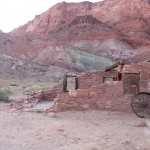
You can drive to Lee’s Ferry from Page, Arizona, and wonder at the hogback-dominated vistas on the way. You cross Marble Canyon on a spectacular new highway bridge overlooking a once-spectacular 1930’s highway bridge and curve down to the wide river on a narrow side road. You pass immense sandstone boulders, some balanced in defiance of gravity, until the road ends at the historic ferry site. Where Zane Grey characters used to wait, you will see river runners. Lee’s Ferry is the major put-in for floats through the Grand Canyon. At night before launching the outfitters sleep in their inflated rafts.
Out of sight of Glen Canyon Dam upstream and the bridges downstream, Lee’s Ferry is like it must have been when John D. Lee took refuge there in 1871. The BLM has preserved his Lonely Dell Ranch, named by a privileged wife, Emma.
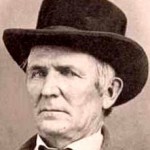
He was the only man convicted in the Mountain Meadows Massacre, a dark place in the history of the church. On Sept. 11, 1857, a Mormon militia accompanied by “Indians” wiped out a wagon train of affluent Arkansas families bound for California. A hundred – maybe 120 or 140 – men, women and children were murdered. Only 18 very young children were spared, and all but one, who was given to a Mormon family, were returned to relatives. This salvation may have been due to a passage in the Book of Mormon that says taking “innocent blood” is an abomination to God. Or it might have been due to the probability that they were too young to be credible witnesses. The livestock and possessions were spread among Mormons and Indians.
Twenty years later, a jury of 12 Mormon men found Lee guilty of murder as a participant and he was sentenced to death. No one else was ever tried, though many were accused and went into hiding. For 150 years the atrocity has been publicized repeatedly by sensational anti-Mormon writers dwelling on the question of Brigham Young’s complicity. The reliable first-source account by Juanita Brooks, published by Stanford University in 1950, presents nothing that would stand up in court, in my opinion. The massacre was deeply influenced by a state of war provoked by the bad judgement of President James Buchanan. He ordered a thousand soldiers west to subdue a religious population that feared all Gentiles. The past – including the martyrdom of Joseph Smith and the persecution in Missouri and Illinois that forced the Saints into exile – was not history, as William Faulkner said of the Civil War in the South, it was not even the past.
Brigham Young handed down defense strategies that included scorched earth retreats, stockpiling of ammunition and food, and refusal to sell provisions to wagon trains passing through Utah. He encouraged alliances with local Indian groups, advising as he put it in at least one letter: “They have either got to help us or the United States will kill us both.” Ten days before the massacre he met with Indian leaders in Salt Lake and noted afterwards in his diary, “I can hardly restrain them from exterminating the Americans.”
Proving that he ordered the Mountain Meadows Massacre, however, is as specious as indicting Gen. William Westmoreland for the My Lai Massacre in Vietnam or Colorado governors for the Ludlow Massacre or the Sand Hills Massacre. Or, for that matter, Barack Obama for the bombing of the Doctors without Borders hospital in Afghanistan. There is a presumption of executive immunity, except where high officials get involved in details, as Kissinger did in selecting targets for bombing in Cambodia. It goes on and on. . . .
Of the anti-Mormon books the most recent best seller is “An American Massacre” by Sally Denton of Santa Fe, who profiled the victims from information passed down by their families for generations. It’s a heartbreaking story told in part from the imagined point of view of the saved children.
By contrast, Juanita Brooks was an exemplar of Mormon scholarship, devoting most of her professional life to documents for her history, “The Mountain Meadows Massacre,” and her biography, “John Doyle Lee.”
She tells how the men of the migrant party, besieged by Indians (probably Paiutes), were convinced by Lee and others to disarm. They walked from the defensive circle of wagons, each accompanied by an armed Mormon guard. When signaled to halt, each guard shot his companion. Then Indians hiding in the brush killed the women and children who trailed the men. And Lee and others killed the sick and wounded in wagons. “In these essentials,” she wrote, “all accounts agree.”
In his “Confessions,” Lee acknowledged being a go-between and that the immigrants trusted him. As to the murders, he said only that he did his “duty” and that on signal “we proceeded to do our part.” It is the language of soldiers even today.
On March 23, 1877, wagons took John D. Lee and a coffin to Mountain Meadows. He sat on the end of the coffin for pictures. He handed a letter to a lawyer friend. He stood without a blindfold. A firing squad fired well-aimed shots to his heart.
He was an avid lifelong Mormon who fathered 60 children with 19 wives. He was excommunicated and marked as the scapegoat, he believed, as do most historians. The governing body of the LDS Church reinstated him in 1961. Among his many successful descendants are the political Udalls of Arizona, New Mexico and Colorado.
In his death letter Lee denounced his former mentor Brigham Young. And he wrote, “I ask God in Heaven, in the name of His son Jesus Christ, to receive my spirit, and allow me to meet my loved ones who have gone behind the vail.” It is Mormon doctrine that families, through devout temple “sealing” rituals, may be united eternally.
NAUVOO
My firstborn daughter, Lara, died of undiagnosed cardiomyopathy in her sleep on May 3, 2015, in Chicago. Pat and I were in New York at my sister’s upper eastside apartment when the call came. I was so stunned and heartbroken I could not speak. I could only walk silently to Central Park and walk and walk and walk. We were graced by a warm spring day. I was not graced by a belief in heaven.
In June I had to drive to Chicago to dispose of Lara’s possessions. I kept the things she valued – her thesis notes for the School of the Art Institute where she was pursuing a Master’s degree, and her paintings, drawings, journals, beadwork, jewelry, fashion dolls, decorated furniture, patchwork quilts and cushions and other handiwork. They filled my Honda Element and the rack on top.
I wanted to avoid the Interstate highways on the way home to Colorado. Their sameness and repetition facilitate too much thought. So I set out blindly for the Mississippi on rural roads in southern Illinois. The name Nauvoo was in my mind. It was a successful distraction for a while.
Nauvoo, named by Joseph Smith who said it meant good place with good people, was once a community of 12,000 Saints on the east bank of the Mississippi. They had been driven from Missouri after the Haun’s Mill massacre of a dozen of them by a citizen militia in 1838 a few days after Missouri Gov. Boggs issued an order that the Mormons “must be exterminated or driven from the state.” The Mormons moved again. At Nauvoo they cleared and drained and cultivated the rich land. They built homes and shops out of brick from their own kilns. They built a high limestone temple on the hill above the town. Their numbers grew, rivaling Chicago in population.
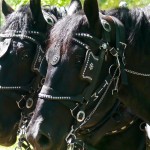
I arrived at sunset and saw the temple, a replica of the original, dedicated in 2002 at the same site. It is 54,000 square feet and 162 feet high to the top of Moroni. Next morning I stopped at the visitor’s center and got a free ticket to ride one of the percheron-drawn tour wagons. Mormon men in straw hats drove the matched horses with subtle, almost undetectable movements. A mere touch of the whip tassel would speed those beautiful animals. I admired the traditional culture that still valued them and used them.There are two dozen buildings in the church’s restoration of Nauvoo, still in progress. The wagon passed shops where costumed guides were demonstrating the impressive skills of 19th Century America.
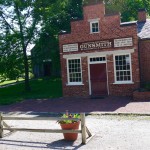
One of the most popular sites is the home and workshop of the gunsmith Jonathan Browning, inventor of a repeating rifle that sometimes bore an inscription: “Holiness to the Lord – our preservation.” His son John Moses Browning invented the famous Browning automatic rifle known by American troops from Word War I on as the B.A.R.

Nauvoo was a prosperous community united in one religion. Then, on June 27, 1844, Joseph Smith was assassinated at the nearby Carthage, IL, jail. I pulled into the parking lot of the visitor’s center by the restored stone building just after closing time. An LDS elder in a suit and tie met me at the door and offered to take me on an after-hours tour. We walked up the flight of wooden stairs to the disgusting jail. The elder narrated that as a mob gathered outside, the prophet and his brother Hyrum and two others were moved for their safety to a bedroom at the head of the stairs. They locked the door. Armed men with blacked faces charged up the stairs. He showed me where a shot had shattered the door lock. He showed me the window Joseph Smith jumped from, receiving fatal wounds as he fell.
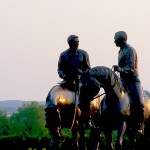
I had seen the statue in front of the Nauvoo temple of Joseph and Hyrum on horseback, taking their last look at the town below before they rode away to Carthage. I asked why such powerful men would ride to their own death. The elder said, “Joseph Smith believed in the Constitution.” They were answering a summons to appear in court on charges related to the destruction in Nauvoo of a strident opponent’s printing press.
The elder mentioned one leading reason for the assassination was that Joseph Smith wanted to run for president of the United States – an idea supported by some of the histories, noting it would not be long before another Illinois figure actually was elected president. I mentioned the irony that religion was never a prominent objection to candidacy of Mitt Romney.
The elder gave a brief account of the exodus and pointed out that the Moroni on the restored Nauvoo temple faces west, the direction of the pioneers.
Returning toward the visitor’s center, the elder asked how I happened to stop by. I said my daughter died in Chicago.
“When?”
“May Third,” I said. I pointed to the loaded Element, which, of course, he had already surveyed. “I am taking her things home.”
“What was the cause of death?”
Most people, I found, offer consolations without asking for details because of the anticipated emotional effect. Was this Mormon therapy?
“Heart failure,” I said. “She was always a good girl. A very loving person. Not depressed. Never used drugs. . .”
Suddenly I was choking up. I could not go on. He invited me inside the visitor’s center where two young women were waiting for him – probably his daughters. He introduced me, but I could not hear or speak. He handed me a copy of the Book of Mormon and said, “I can have someone come to talk to you in Colorado.”
I walked away with a quick and silent wave.
In my car I screamed as if to the Lord.
Why did I cry there? Because I was a stranger in the presence of a church that had conquered death. Its sacred sealing rituals somehow assured that families would be together in Heaven. What was the power of the church? That was it. . . .
At home at the end of this sad summer I thought of the connection between the high school reunion and the journey through Mormon land. It was not essentially that “South Park” and “The Book of Mormon” were written by the same two unrelenting satirists. It had something to do with living in the past when that’s all you’ve got left. Memories of high school. Memories of my daughter.
Ever since Ram Das wrote “Be Here Now” in a trailer in northern New Mexico, American seekers have counseled that we should live in the moment, not the past or future. This fundamental principal of meditation – awareness of the delusionary stream of discursive thought – has evolved into a religion of “non-dualism,” with constant Eastern references. But separation of “now” and the past and future “then’s” of our stream of thought is dualism. Do not reject the past, I thought. Integrate it.
A few days before Lara died I saw a poem posted on a Lexington subway car by an arts group. For some reason – perhaps because of its contrast with the hurried crowd around me – I tried to memorize it. Some say God gives us the means to deal with the worst things. They are the same people who will say Lara is now with her mother, who died 14 months before her.
The poem was:
It will be in the past
and we will live there together.
Not as it was to live
but as it is remembered.
It will be the past.
We’ll all go back together.
Everyone we ever loved,
and lost, and must remember.
It will be the past.
and it will last forever.
The title of this poem by Patrick Phillips is “Heaven.”
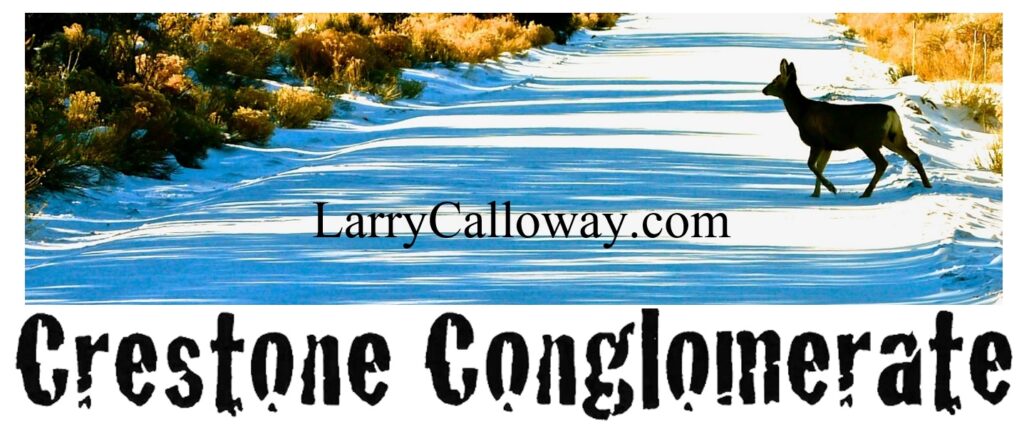
Larry, thanks. There’s a lot to think about in this one; great juxtapositions with the Rebs and Mormons and South Park. A year or two ago the book club read The 19th Wife, by David Ebershoff, which was my first journey of any length into Mormon history and culture. A fascinating book and interesting discussion. I’d forgotten a lot of the historical details as I read your post but at least had a little more context than I would have otherwise…
I was disappointed, from a human standpoint, that after drawing out details from you about Lara’s death, the visitors’ center fellow used the opening for such a shameless (in my view) attempt at prosthelytizing, even though I’m sure he believed he was offering you a priceless gift. And you were informed enough to know what he was offering, even though it wasn’t what you needed…
I like your idea about integrating the past. It forms who we are even as we try to “be here now.” Your recent experiences along with history that people passed along to you mixed with your own personal suffering show the complexity of a good man.